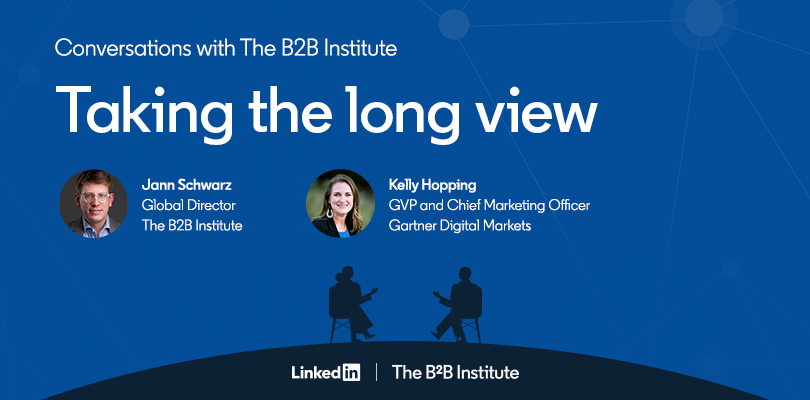Focusing on the Indirect Impact of Brand on Performance is Key
As part of the “Taking the Long View — Conversations with The B2B Institute at LinkedIn” series, B2B Institute Global Director Jann Martin Schwarz interviewed GVP and Chief Marketing Officer of Gartner Digital Markets, Kelly Hopping. Kelly has a direct view into how thousands of software and services companies are marketing to SMBs and how that has changed in recent months.
Jann Martin Schwarz: How did you end up in a CMO role and what got you first interested in a marketing career?
Kelly Hopping: I never actually intended to be a marketer. I have an industrial engineering degree from Texas A&M University, but I never really wanted to be an engineer either. I just wanted to get the best possible degree I could get from my favorite university (Whoop!) and then I figured that I would see where that led and eventually get my MBA. This was 1999, so the market was red hot. During my last semester in school, I accepted an internship to do product development at Sabre (then owned by American Airlines). The day before my internship began, my future boss called me and said “We have had a re-org, and I am now the VP of Product Marketing. How would you like to do marketing for the summer?” I jumped at the opportunity, and it turns out, I love marketing! I’ve been doing marketing ever since. A few years later, I went to Harvard Business School to get my MBA so that I could learn to be a “proper marketer.” Over time, I’d love to evolve even more into a COO or CEO in a marketing-driven company.
Jann: Tell us about your current role.
Kelly: I am the CMO for a portfolio of IT services, including Capterra. Our mission is to help small and medium businesses find the right software and services to meet their needs. I believe that people trust the experience of other organizations more than what a marketing campaign tells them. Crowdsourced technology reviews and insights help people feel more confident in their buying decisions. I think Capterra is best positioned in the market because we are the leader in our space with over 1.2 million verified, legitimate user reviews across over 50,000 products in more than 700 categories of software. We are a one-stop-shop for finding the best technology for your mission-critical priorities.
Jann: You have a unique window into the mind of small and medium-sized businesses as they make decisions that are really critical at the moment, in terms of what software and products to buy, as well as ways these tech companies are marketing to their prospects.
Our B2B Institute think tank has a hypothesis that emotions in B2B marketing are very much undervalued because there’s always this notion that software gets sold because of the specs, functionality, and competitive pricing. Ultimately though, most of your prospects are not in market for a particular piece of software all the time. That’s when we think B2B brands should build equity with emotional, memorable creative. Do you agree?
Kelly: I agree, B2B marketing really has to be treated like consumer marketing, which has a lot more emotion; it’s got more personality, it’s much more memorable. It’s not just stock photos of guys in suits seated around a boardroom table. Now entrepreneurs are wearing jeans at a coffee shop – they’re doing business everywhere. It’s also not all white men anymore – people look different.
I think B2B advertising historically has been rather boring. There was a short list of places where you could do that type of advertising. You did it in Fortune magazine, you did it in The Wall Street Journal, and you did it at an airport in the premium lounges.
Good creative is hard to do well, but if you can do it well, it’s so much more relatable. Being able to tap into that human insight and relate it to a business is pretty fascinating.
Jann: What would be some specific examples of brand measurement in that framework that you just established? What would you say are the most important KPIs?
Kelly: Obviously you have the original ones, you have your brand awareness numbers - unaided or aided — and you can look at that full funnel from awareness to consideration to preference. You can measure all of that with a representative sample, and you should.
But I think focusing on the indirect impact of brand on performance is key. How is a brand campaign you ran concurrently raising the click-through rate of your performance campaign?
If you benchmark performance media on what you’ve always spent but you’re now also running brand spend, you should expect that the click-through rate on your mid or bottom-of-the-funnel elements should go up, meaning everything should work harder because of that brand spend. Organic search traffic should go up too, because people will actively look for you by your brand name. Repeat traffic to a site is also interesting to watch as it results in better conversion rates at a higher lifetime value (LTV), as people trust the familiar.
Jann: I also find that most marketers apply too short a timeframe when evaluating the impact of branding.
Kelly: Time horizons are key – having more of a lifetime value than transactional mindset. Many brand activities are not going to pay off in 30 days or 60 days; you’re really looking at 9-12 months before you see impact. I can see that the value from someone who interacted with our site 9 months ago versus 12-18 months ago is getting higher and higher over time because they’ve become more comfortable with our brand.
At Capterra, we can very precisely attribute our revenue to specific marketing channels for the first time in my career. So we don’t have to spend time arguing about marketing’s contribution to revenue. However, that only captures last click revenue based on bottom-of-the-funnel spend. Attributing revenue to top and middle of the funnel investments is much more complex.
Jann: Sales is no longer an in-person sport because we can’t do it in person. In some categories, I think this is going to stick because it’s not just a crisis, it’s also new generations of businesspeople who don’t want to be taken out to the steak dinner and have a relationship with someone who’s their sales rep.
They are actually much more interested in having their questions answered 24/7 through chat, like when they are buying shoes from Zappos. So, what is the sales org of the future going to look like from your perspective?
Kelly: There’s so many elements to that. At the very high end of deal sizes, I don’t know that the old school way of in-person sales with relationship-building over golf games and steak dinners will disappear completely, although it will probably be less of a “boys club.” I do, however, think that this world will become a much smaller piece of the overall sales pie. SaaS will continue to grow because you can get in and out fast, which means the risk of making a bad decision — other than the time you may waste on implementation and contracts and things like that — is much lower. If you hate it, then in 30 days you cancel it.
This doesn’t mean that salespeople can’t continue to thrive and have great careers, but they have to learn to build relationships digitally, and with an eye to speed, scale, and volume in addition to quality of the relationships.
Jann: How do you build strong relationships with all the parts of the business? I see that as a real need for younger people who are rising through the marketing ranks. They may really know their stuff, but they speak in a language that is indecipherable to anyone else who doesn’t work in that world. What’s your take on that?
Kelly: I agree with everything you just said. The advice I always give young marketers is “if you want to become indispensable in this organization and you want to provide real strategic value to this organization, sit down and study the business, study the P&L, learn about how the economics work, spend time in the balance sheet, figure out where our debt is, figure out where we’re investing, figure out which parts of the business are growing, which parts are not, which ones are most profitable.” If you can understand the macro picture, then you can connect what you’re working on to what the senior leaders care about.
The one thing that’s made a difference on the opportunities I’ve been given is that I spent a lot of time trying to understand the business as a whole. That understanding enabled my relationships with my bosses to be more intellectual and economical in nature. We were able to have big strategic dialogues, and I could come up with actual ideas that fit into our competitive differentiation, that fit into our value proposition, that were financially viable, that actually opened up a lot of doors throughout my career.
The best advice I can give to anyone is that you should try to understand the macro and micro economics of the business. This helps provide you with the context of how what you’re doing as a marketer fits into the bigger strategy. It also helps perpetuate the value of marketing as a strategic business partner, rather than a cost center.




